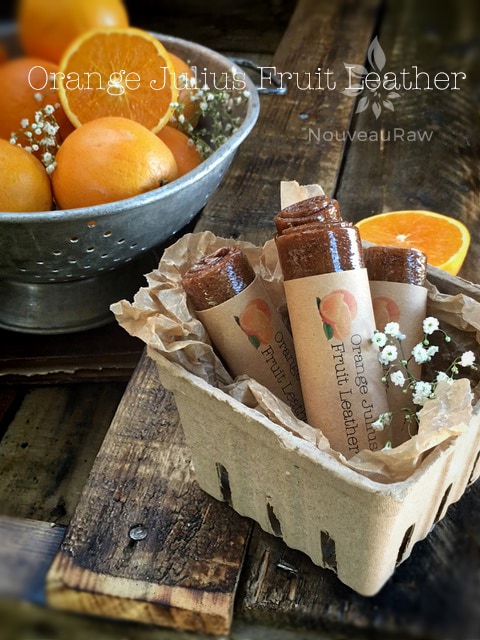Orange Julius Fruit Leather

 Add to favorites
Add to favorites

~ raw, vegan, gluten-free, nut-free ~
It’s time to take fruit leathers to a whole new nutritional level!
Mesquite is of particularly great value to those looking to balance blood sugar levels. Mesquite flour adds a naturally sweet flavor to recipes, but its sugars are derived from fructose (which does not require insulin to digest and is readily metabolized).
Additionally, the flour is an excellent form of fiber – meeting almost a quarter of daily needs in just two tablespoons – which not only improves digestion but further benefits sugar metabolism.
The Power of Mesquite
Mesquite also contains lysine (an amino acid), as well as notable quantities of digestible protein, calcium, magnesium, potassium, iron, and zinc. As such a balanced food, it is easy to see why Native American ancestors relied so heavily on mesquite as a staple form of delicious nourishment.
Mesquite flour is a unique ingredient to add to recipes. It carries a sweet, smoky flavor that is similar to carob, with caramel undertones. Its rich taste and aroma pairs well with both vanilla and chocolate, and it lends a delightful maltiness when used in sweet treats.
It is an excellent addition to smoothies and is fantastic when sprinkled into ice cream. Exquisite malty chocolate can be concocted with this ingredient, and Mesquite can also be used as an aromatic partial flour substitute. This is a fantastic food to experiment with. {source}
I hope you enjoy this recipe. Blessings, amie sue
Ingredients:
yields 3 1/2 cups puree
- 4 bananas, ripe
- 2 oranges, peeled
- 1 scoop protein powder
- 1 Tbsp mesquite flour
- 1 vanilla bean, seeds only
- 1 tsp vanilla extract
- Zest of one orange (1 1/2 Tbsp)
Preparation:
- Select RIPE or slightly overripe bananas and oranges that have reached a peak in color, texture, and flavor.
- Puree the fruit, protein powder, mesquite flour, vanilla bean seeds, and vanilla extract, in the blender or food processor until smooth.
- Taste, and sweeten more if needed. Keep in mind that flavors will intensify as they dehydrate.
- When adding a sweetener do so 1 tbsp at a time, and reblend, tasting until it is at the desired taste.
- It is best to use a liquid type sweetener. Don’t use a granulated sugar because it tends to change the texture.
- Pulse in the orange zest.
- Spread the fruit puree on teflex sheets that come with your dehydrator.
- Pour the puree to create an even depth of 1/8 to 1/4 inch. If you don’t have teflex sheets for the trays, you can line your trays with plastic wrap or parchment paper. Do not use wax paper or aluminum foil.
- Lightly coat the food dehydrator plastic sheets or wrap with a cooking spray, I use coconut oil that comes in a spray.
- When spreading the puree on the liner, allow about an inch of space between the mixture and the outside edge. The fruit leather mixture will spread out as it dries, so it needs a little room to allow for this expansion.
- Be sure to spread the puree evenly on your drying tray. When spreading the puree mixture, try tilting and shaking the tray to help it distribute more evenly. Also, it is a good idea to rotate your trays throughout the drying period. This will help assure that the leathers dry evenly.
- Dehydrate the fruit leather at 145 degrees (F) for 1 hour, reduce temp to 115 degrees (F) and continue drying for about 16 (+/-) hours. The finished consistency should be pliable and easy to roll.
- Check for dark spots on top of the fruit leather. If dark spots can be seen it is a sign that the fruit leather is not completely dry.
- Press down on the fruit leather with a finger. If no indentation is visible or if it is no longer tacky to the touch, the fruit leather is dry and can be removed from the dehydrator.
- Peel the leather from the dehydrator trays or parchment paper. If it peels away easily and holds its shape after peeling, it is dry. If it is still sticking or loses its shape after peeling, it needs further drying.
- Under-dried fruit leather will not keep; it will mold. Over-dried fruit leather will become hard and crack, although it will still be edible and will keep for a long time
- Storage: To store the finished fruit leather…
- Allow the leather to cool before wrapping up to avoid moisture from forming, thus giving it a breeding ground for molds.
- Roll them up and wrap them tightly with plastic wrap. Click (here) to see photos of how I wrap them.
- Place in an air-tight container, and store in a dry, dark place. (Light will cause the fruit leather to discolor.)
- The fruit leather will keep at room temperature for one month, or in a freezer for up to one year.
Culinary Explanations:
- Why do I start the dehydrator at 145 degrees (F)? Click (here) to learn the reason behind this.
- When working with fresh ingredients, it is important to taste test as you build a recipe. Learn why (here).
- Don’t own a dehydrator? Learn how to use your oven (here). I do however truly believe that it is a worthwhile investment. Click (here) to learn what I use.
© AmieSue.com
Tags: Gluten Free, Nut Free, Refined Sugar Free, Soy Free, sugar free, Vegan



 Add to favorites
Add to favorites
Hi Amie Sue, Can the protein powder be left out of this recipe without any negative side effects? Thanks!
Hi there Gay… It can be omitted, it will change the taste though. amie sue